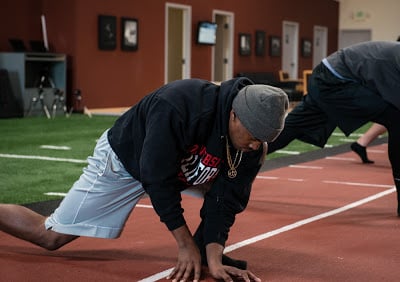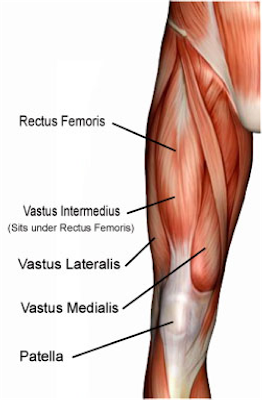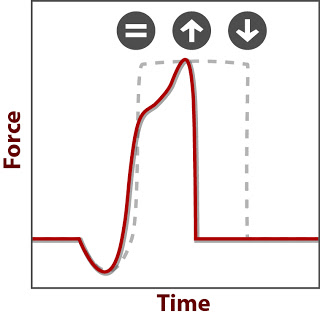
The strongest bone in your body requires some heavy duty muscles to control it. Thankfully the body has the quadriceps femoris, Latin for the “four headed muscle of the femur”. It is one of the the 3 most strained muscles amongst athletes, along with the hamstrings and adductors. However, quadriceps strains have been found to cause more missed games, so the consequences top the list.
All of these soft tissue injuries result from eccentric stress, the sudden lengthening of the tissue due to a change in direction. But what differentiates which muscle groups (quads vs. hamstrings vs. groin) are placed under stress, is the plane of this direction change, and the subsequent ways to treat such injuries.
Here is a quick overview of how this 4 headed muscle is divided, starting with the first layer of 3 muscles.

Three of the muscles originate from the body of the femur bone; they are called vasti, plural for vastus. These muscles are named by their location relative to the femur bone; vastus lateralis, vastus medialis (VMO), and vastus intermedius.
Overlying these 3 muscles is the rectus (“straight”) femoris, which is unique for several reasons. The first characteristic is the bipennate nature, where the fibers on either side converge to a central tendon. This feather like appearance with fibers on each side, allows more tension to be created by shortening less.
The second defining characteristic is the biarticular aspect, meaning it crosses 2 joints. This coverage allows the muscle to both flex the hip and extend the knee, a direct antagonist to the hamstrings.
The third unique trait of the rectus femoris is the 65% composition of fast twitch fibers, one of the highest in the human body. Due to this greater role in explosive movements, as well as its biarticular nature, the rectus femoris, is the most prone quadriceps muscle to injury.

Strains of the quadriceps are most common in sports that involve repetitive sprinting and kicking.
According to an April 2013 review cited at the bottom, the most common site occurs in the middle or lower part of the thigh where the muscle becomes a tendon.
So if muscles are always at risk for strains in eccentric actions, we must look for the point of maximal elongation to identify when the injury occurs. In situations like sprinting, the rectus is most lengthened when the opposing leg contacts the ground. Therefore, the at-risk leg is transitioning from full hip extension to maximal hip/knee flexion (knee drive). It is the start of the swing phase, shown to the right.
This same mechanism can be applied to kicking. As the leg is swung backwards, the rectus femoris is stretched and forced to decelerate the momentum of the kicking leg for a powerful swing forwards.

We see all soft tissue injuries sharing the same Movement Signature of flexed. These athletes are at risk for all soft tissue injuries, but the specific muscle at risk depends on the direction of movement.
There are aspects we can learn from Crossfit, especially the concept of WODs. We have been using this idea for years, just calling the pairings blocks.
Strength – With any acute injury, the goal is to avoid lengthening or stretching of the tissue, so concentric, or shortening movements work best. Slow, concentric movements are fantastic in maintaining strength during the recovery period without irritating the inflamed region. So with all of our acute soft tissue injuries (muscle strains/pulls) we prescribe the deadlift.
Skills – The injury occurs because the leg gets TOO far behind you in sport, so we have to restore the proper stability above the injury to return proper length and mechanics. Our favorite stability exercise for the hip (joint above the quad) is the glute bridge.
Regen – This review also makes a great point on the main culprits in rectus strains, which is one of the other hip flexors, the iliopsoas. A tight psoas restricts hip extension, requiring the rectus femoris to generate more force, fatigue, and possibly tear. The second reason is the femoral nerve which passes through the psoas muscle can become irritated from tightness in the muscle, causing tension further down in the chain in the rectus. So we use the hip mobilizations, popularized by Mobility Wod, to release that filet mignon and the other hip flexors.
So do not get behind yourself, start preventing those quad strains.
Mendiguchia J, Alentorn-Geli E, Idoate F, Myer GD. Rectus femoris muscle injuries in football: a clinically relevant review of mechanisms of injury, risk factors and preventive strategies. Br J Sports Med. 2013 Apr;47(6):359-66.